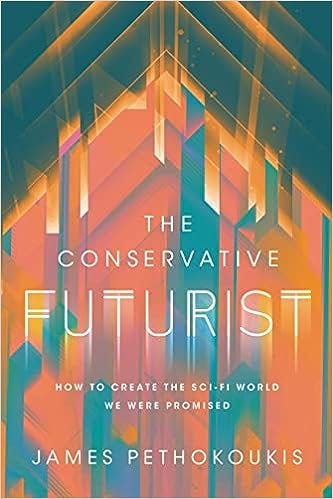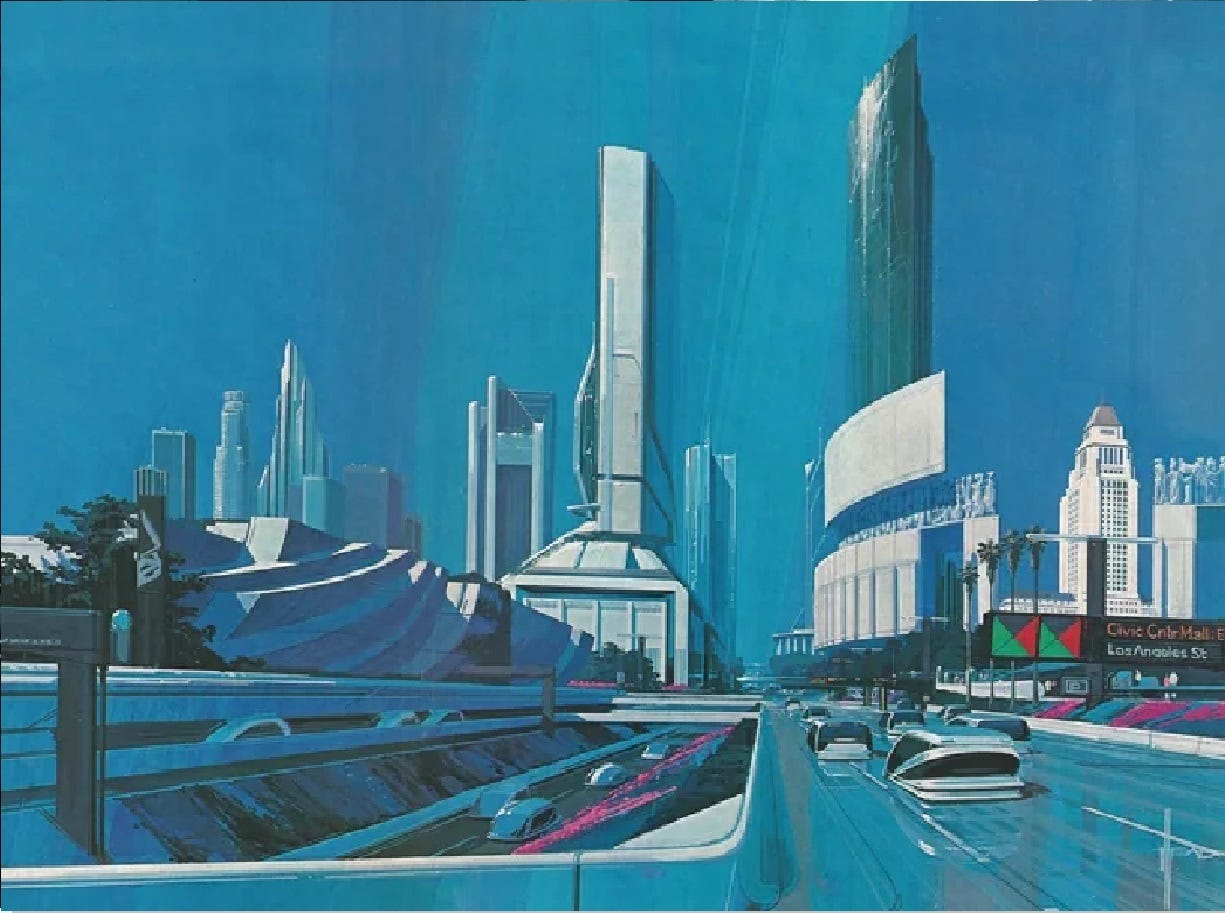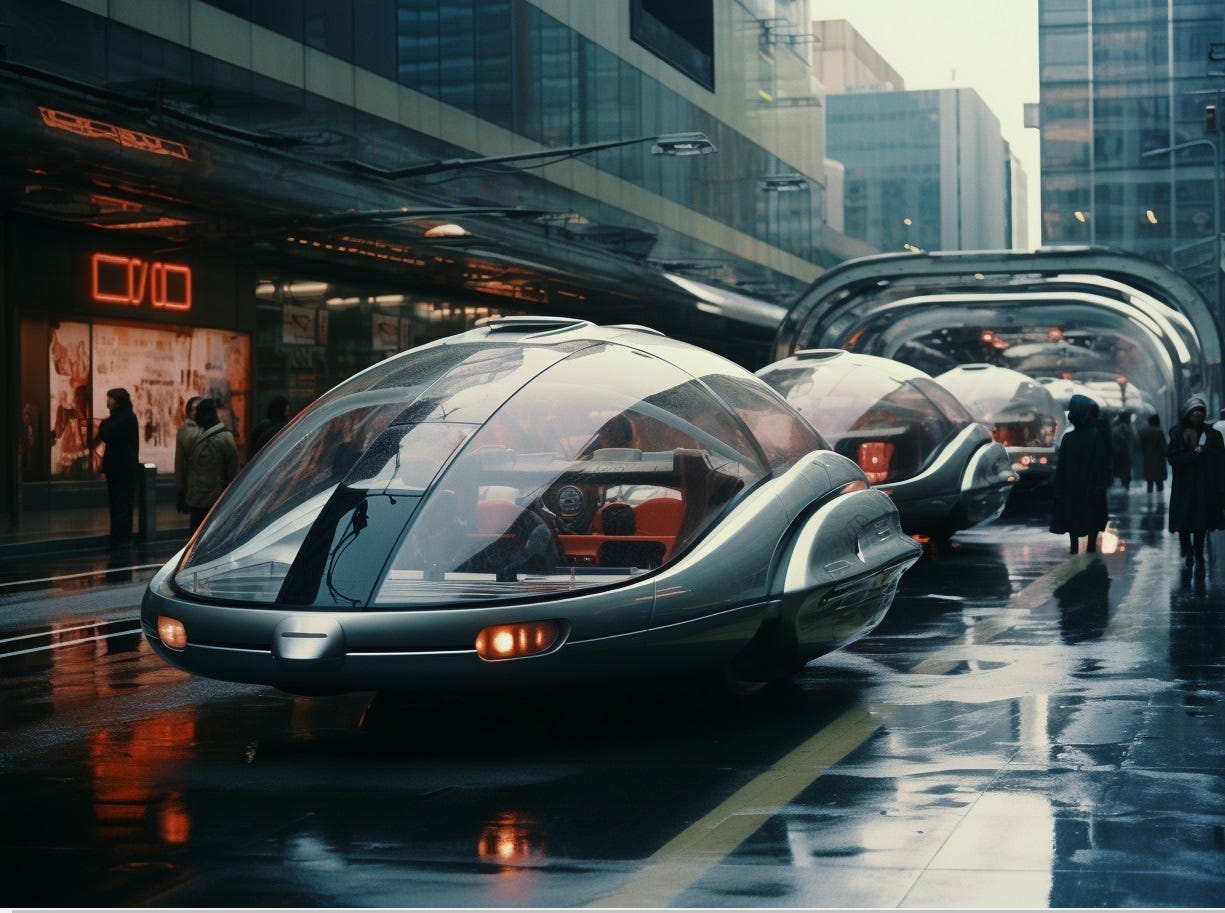🚘 Beyond the hype: Self-driving cars shifting into high(er) gear
Robotaxis can be found in more and more places in more and more cities.
Quote of the Issue
“In the modern world, success came from having the largest possible educated population and providing those hundreds of millions of creative people with credible freedom.” - Vernor Vinge, Rainbows End: A Novel with One Foot in the Future
I have a book coming out on October 3. The Conservative Futurist: How To Create the Sci-Fi World We Were Promised is currently available for pre-order pretty much everywhere, including Amazon. I’m very excited about it!
The Essay
🚘 Beyond the hype: Self-driving cars shifting into high(er) gear
Item: California regulators voted in favor of robotaxi operators expanding their paid driverless services in the city of San Francisco, a major milestone toward commercializing the technology. The state’s Public Utilities Commission voted 3 to 1 to allow General Motors’ Cruise and Alphabet’s Waymo to increase the areas of the city where they can operate a car without a safety driver, and charge riders a fare for it. … Robotaxis have increasingly become a normal sight on the Northern California city’s roads, with Waymo running a fleet of about 200 cars. Such services are currently limited in where they can drive, and the companies typically can’t charge passengers. Cruise has 300 cars across three cities — San Francisco, Austin and Phoenix — averaging 1,000 trips a day. Both services have thousands of individuals on waiting lists to try them out. - Bloomberg, August 11, 2023
Twenty-first-century fears about technological automation didn’t begin this past November when OpenAI launched ChatGPT, the large language model-based chatbot. In the decade before the COVID-19 pandemic, there was increasing concern about “robots stealing all the jobs” — well, at least once we all stopped worrying about global financial collapse.
Those worries, I would argue, began when Google announced in an Oct. 9, 2010, blog post that the company had “developed technology for cars that can drive themselves. … While this project is very much in the experimental stage, it provides a glimpse of what transportation might look like in the future thanks to advanced computer science. And that future is very exciting.”
But not everyone saw it as “very exciting.” It didn’t take much nudging for a society soaked in techno-dystopianism to begin obsessing about the downsides to autonomous vehicle technology and, more broadly, artificial intelligence and robotics. If a car could accomplish one of the seemingly most difficult tasks that humans do, surely there would be many other human activities — and jobs — these brilliant machines could also do. It wasn’t just the long-haul truckers who had to worry.
What’s more, our imaginative speculations were bolstered by scholarship. In 2013, two Oxford scholars, Carl Benedikt Frey and Michael Osborne, concluded that 47 percent of employment in America is at high risk of being automated away over the next two decades.” It was a forecast that seemed even more reasonable after Elon Musk in 2015 predicted that Tesla cars would drive themselves in two years. (In 2019, Musk suggested that Tesla would have a million robo-taxis operating on public roads by the end of 2020.) Such predictions, and our fear of them, are what helped Andrew Yang gain a bit of presidential buzz in 2019 with his dire warnings about a jobless future and the solution of a universal basic income:
All you need is self-driving cars to destabilize society. ... That one innovation will be enough to create riots in the street. And we’re about to do the same thing to retail workers, call center workers, fast-food workers, insurance companies, accounting firms.
But self-driving technology has proven to be a tougher problem to solve than thought back in 2010. There are not, you may have noticed, a million Tesla robo-taxis cruising along highways and through the downtowns of big U.S. cities. Just a year ago, there were plenty of pessimistic headlines:
“Even After $100 Billion, Self-Driving Cars Are Going Nowhere” - Bloomberg Businessweek
“Slow Self-Driving Car Progress Tests Investors’ Patience” - The Wall Street Journal
“As Driverless Cars Falter, Are ‘Driver Assistance’ Systems in Closer Reach?” - The New York Times
“The problem with self-driving cars? Many don’t drive themselves.” - The Washington Post
There’s a lesson here, one we should remember when thinking about generative AI systems such as ChatGPT. New technology can generate lots of hype followed by lots of disappointment. But that doesn’t mean the technology is junk or will never fulfill anywhere near its original promise. Oftentimes, more tech innovation, along with user learning and investment, are needed. This is exactly the sort of phenomenon we’ve been seeing with self-driving tech. From The Economist in April:
Cruise, a subsidiary of GM, is adding paid driverless rides in Phoenix, Arizona, and Austin, Texas, to the service that it launched for the public in San Francisco in February 2022. Waymo, the self-driving arm of Alphabet, Google’s parent company, operates in Phoenix and San Francisco. Uber’s app with vehicles from Motional, a joint venture between South Korea’s Hyundai and Aptiv, an American supplier, allows the hailing of self-driving rides in Las Vegas. Amazon is running robotaxis between its offices in San Francisco, operated by Zoox, a self-driving startup that it bought for $1.3bn in 2020. In China Baidu, a tech firm, is operating similar services in several cities. Didi, a ride-hailing giant, and WeRide, an av startup that has teamed up with gac, a car firm, are testing out robotaxis in some Chinese cities.
Since that piece came out, there’s been continued incremental expansion. Waymo has expanded its autonomous taxi service in San Francisco and the greater Phoenix area, while Cruise has expanded its robotaxi service to Houston and Dallas. Waymo also recently announced it will expand its autonomous rideshares to Austin, Texas, its fourth city. And now the big news about full expansion in San Francisco.
As tech journalist Timothy Lee told me last year about the future of self-driving vehicles:
Pethokoukis: Autonomous cars may not have lived up to expectations, but there are actual self-driving cars on the road in America today. If our previous expectations about this rapid deployment were wrong, what do you think are reasonable expectations for the next five to 10 years? Will it move beyond being a limited area, almost experimental thing to something widely used?
Lee: I think it will. I think there's a lot of uncertainty about the timeline because as we've seen, it's hard to predict. The two leading companies are Waymo and Cruise, and both of them are planning to grow by a factor of like 10x to 100x over the next two or three years. I think that's probably too optimistic. Currently they're in a couple of cities. I would expect to see that number grow significantly, maybe a dozen cities in two or three years and dozens or hundreds of cities in five to 10 years, something like that. There's a lot of uncertainty about the exact timeline, but if you go to Phoenix there are real driverless cars that can take you around. It's a 180 square mile area of Phoenix that includes downtown Phoenix and gets you to the Sky Train that gets you to the Phoenix airport. So that's like a genuinely useful taxi service. I don't think it's profitable yet. I think that most of the technical problems have been solved, and a lot of it is just kind of making the economics work, getting the costs down, and then doing the logistics of rolling out to new cities.
So not a “gradually then suddenly” sort of thing as with going bankrupt, but gradual steps that add up to something significant over time — although not that much time, really, given the Google blog post was just a decade ago.
Incremental progress but progress nonetheless. And let’s remember what we are progressing toward. As Manhattan Institute Jordan McGillis explains in a new report, “Autonomous Now: Why We Need Self-Driving Technology and How We Can Get It Faster,” the potential for AVs to improve road safety and reduce transportation costs remains pretty compelling. AVs equipped with autonomous driving systems are already safer than human drivers and have the potential to significantly reduce the more than 40,000 annual deaths caused by motor-vehicle collisions in the ... The adoption of AVs also promises cost savings due to reduced labor needs, resulting in lower ride-hailing and trucking expenses. The report emphasizes that AVs with Level 4 automation, capable of autonomous driving within specific environments, hold immense potential for safety enhancement and economic benefits. Among his policy suggestions:
To support successful [autonomous ride-hailing], U.S. cities should: (1) allocate curb space to ride-hailing loading and unloading; (2) allow autonomous ride-hails to use preferred lanes; and (3) implement congestion pricing.
State governments should: (1) devote a state policy office to AVs; (2) license ADS similarly to the licensing of human drivers; and (3) invest in quality infrastructure that facilitates autonomous technology without prematurely committing to vehicle-to-infrastructure (V2I) technology.
The federal government should: (1) raise or eliminate AV manufacturing caps; (2) address problems as they arise, rather than before they arise; and (3) use the power of federal highway funding to induce state receptivity to autonomous trucks.
Give the tremendous benefits from mass AV adoption, this is truly a “Faster, Please!” situation.
Micro Reads
▶ Artificial Intelligence and Scientific Discovery: A Model of Prioritized Search - Ajay K. Agrawal, John McHale & Alexander Oettl, NBER | The complexity of the new research frontiers provides one explanation for disappointing recent productivity growth despite exponentially increasing resources invested in R&D. Innovators lack the kinds of science-based predictive theories to search these spaces that underpinned past scientific advances, most notably the predictive tools provided by 19th and 20th century advances in theoretical physics. Many of today’s greatest innovation challenges are in the domain of biology – small molecule-protein binding, gene expression, protein structure prediction, protein design, etc. Scientists hope that AI-based predictive models will provide useful tools to guide search at these challenging frontiers.
▶ Scientific discovery in the age of artificial intelligence - Nature |
▶ One year after the CHIPS Act, Congress is starving science - Ben Ritz and Stephen Verral, The Hill Opinion |
▶ Inside MIT’s nuclear reactor laboratory - Casey Crownhart, MIT Tech Review |
▶ Musk Is Funding Fertility, Population Research in Texas Project - Sophie Alexander, Dana Hull, and Graham Starr, Bloomberg |
▶ The Clean Energy Future Is Arriving Faster Than You Think - NYT |
▶ Republican districts dominate US clean technology investment boom - FT |
▶ The Death of Anti-Nuclearism - Ted Nordhaus, Breakthrough Institute |
▶ Your food could be delivered by an underground robot: Wendy's tests new mobile order system - Saleen Martin, USA Today |
▶ To speed scientific progress, do away with funding delays - Heidi Williams, WaPo Opinion |
▶ The $900,000 AI Job Is Here - Chip Cutter, WSJ |
▶ Uber and Lyft Drivers Have Some Advice for Autonomous Vehicles Set to Swarm the Streets - Aarian Marshall and Caitlin Harrington, Wired |
▶ The Superconductor Sensation Has Fizzled, and That's Fine - Lauren Leffer, Scientific American |
▶ Do large language models understand the world? - Andrew Ng, The Batch |
▶ America’s Top Environmental Groups Have Lost the Plot on Climate Change - Noahpinion |
▶ The Case Against AI Everything, Everywhere, All at Once - Judy Estrin, Time |
▶ TikTok’s Strange Trend of Humans Playing Robots Spurs Hope for US Shopping - Alex Barinka, Bloomberg |
▶ After 25 years of hype, embryonic stem cells are still waiting for their moment - Antonio Regalado, MIT Tech Review |
▶ The US just invested more than $1 billion in carbon removal - James Temple, MIT Tech Review |
▶ Meet the hackers who are trying to make AI go rogue - Will Oremus, WaPo |
▶ Will "godlike AI" kill us all — or unlock the secrets of the universe? Probably not - Emile P. Torres, Salon |
▶ Virgin Galactic just flew again, but is the company going anywhere? - Eric Berger,Ars Technica |
▶ America (Not So Much) On the Move - Timothy Taylor, Conversable Economist |
▶ Jeff Bezos’ Blue Origin Plots Launch of Its Mega Rocket. Next Year. Maybe. - Micah Maindenberg, WSJ |







I, as someone with only experience by reading about it and nothing more. I believe four issues need to be addressed for self-driving to work:
1. Technology: It would need more than just applying LIDAR sensors and/or cameras. Here are a couple of examples as I do not think we can train the models with all possible scenarios that are possible in different lighting, weather, and/or human-driving cars along with self-driving cars conditions and with different car companies using different models/data it would be impossible to have a real self-driving car anytime soon:
https://techcrunch.com/2021/01/16/startups-look-beyond-lidar-for-autonomous-vehicle-perception/ or https://sifted.eu/articles/wayve-autonomous-driving.
We have to include a rule-based engine to make it work, like https://www.oreilly.com/radar/podcast/the-technology-behind-self-driving-vehicles/. I do not know what combination of these will eventually work.
2. Ethical: I do not know who will make the calls on some of the items highlighted in 21 Lessons from 21st Century (https://www.amazon.com/21-Lessons-for-21st-Century-audiobook/dp/B07DHSPZT2/ref=sr_1_1?crid=93D4MEEHJK0A&keywords=21+lessons+for+the+21st+century+yuval+noah+harari&qid=1692111972&sprefix=21+less%2Caps%2C74&sr=8-1); For example, suppose two kids chasing a ball jump right in front of a self-driving car. Based on its lightning calculations, the car’s algorithm concludes that the only way to avoid hitting the two kids is to swerve into the opposite lane, and risk colliding with an oncoming truck. The algorithm calculates that in such a case there is a 70 per cent chance that the owner of the car – who is fast asleep in the back seat – would be killed. What should the algorithm do? s if you program a self-driving car to stop and help strangers in distress, it will do so come hell or high water (unless, of course, you insert an exception clause for infernal or high-water scenarios). Similarly, if your self-driving car is programmed to swerve to the opposite lane in order to save the two kids in its path, you can bet your life this is exactly what it will do. Which means that when designing their self-driving car, Toyota or Tesla will be transforming a theoretical problem in the philosophy of ethics into a practical problem of engineering. Tesla will produce two models of the self-driving car: the Tesla Altruist and the Tesla Egoist. In an emergency, the Altruist sacrifices its owner to the greater good, whereas the Egoist does everything in its power to save its owner, even if it means killing the two kids. Customers will then be able to buy the car that best fits their favorite philosophical view. If more people buy the Tesla Egoist, you won’t be able to blame Tesla for that. After all, the customer is always right. So maybe the state should intervene to regulate the market, and lay down an ethical code binding all self-driving cars? Some lawmakers will doubtless be thrilled by the opportunity to finally make laws that are always followed to the letter. Other lawmakers may be alarmed by such unprecedented and totalitarian responsibility. After all, throughout history the limitations of law enforcement provided a welcome check on the biases, mistakes and excesses of lawmakers. It was an extremely lucky thing that laws against homosexuality and against blasphemy were only partially enforced. Do we really want a system in which the decisions of fallible politicians become as inexorable as gravity?
3. Human Behavior: If humans are driving along with self-driving cars, which will be a scenario for the next few decades, and we all have seen how some people drive, I do not think unless we remove almost all the drivers from the road, we will be able to build a real system where cars communicate with each other to keep us save.
4. Liability: Who takes liability if a car runs into an accident? The owner of the car or car company. This problem can be solved by making cars a subscription rather than owning a car. However, we are at least a decade or two away from this happening on a large scale. Based on my reading on the internet, there are five levels of autonomous driving. Until level 3, the car owner is responsible for car accidents; at four and beyond, it is the car company. Do we believe the car companies will be ready to own millions of cars' liabilities anytime soon? I have my doubts, but others may have different opinions.
To summarize, we will not see real mass self-driving cars on the road in my lifetime. The driver-assist system will improve significantly over time. However, I am optimistic that my son and his generation will see a working system. I look forward to others’ thoughts on this topic to refine my thinking.
Congratulations on your new book. I look forward to reading it.